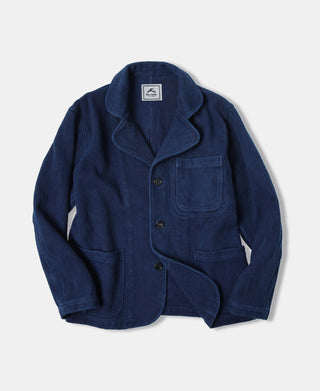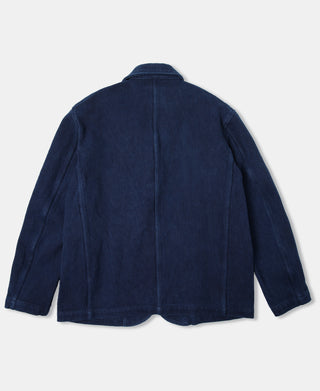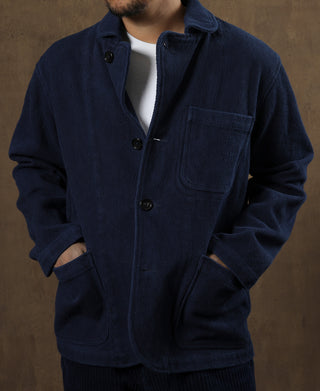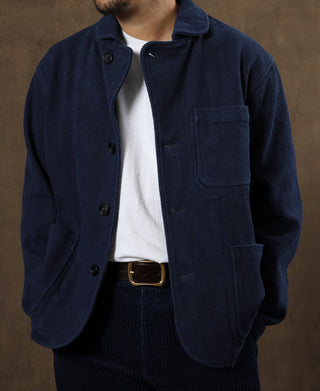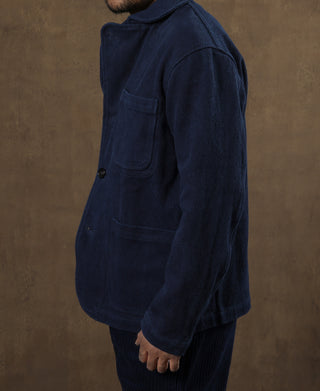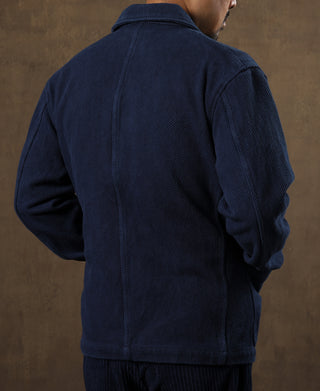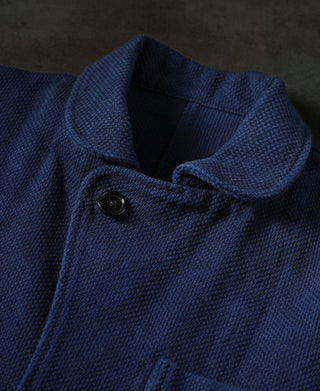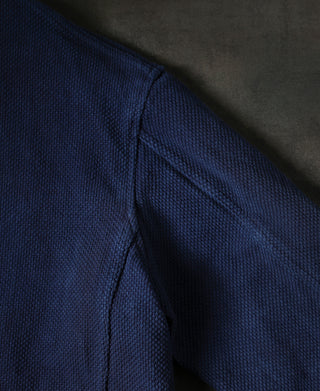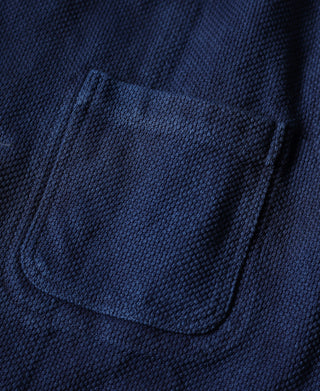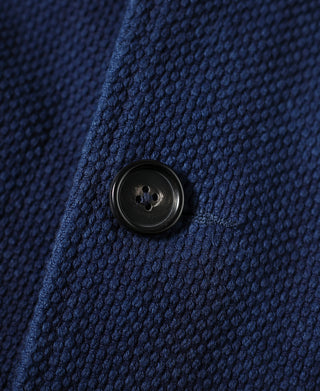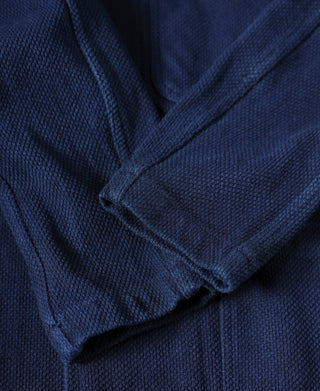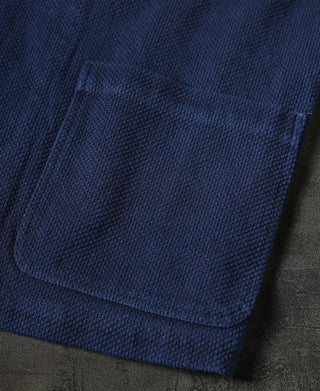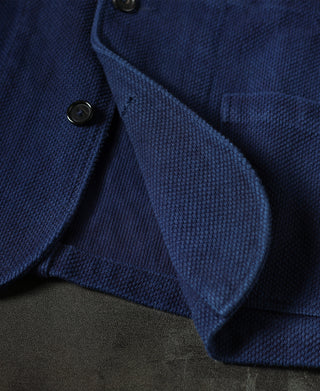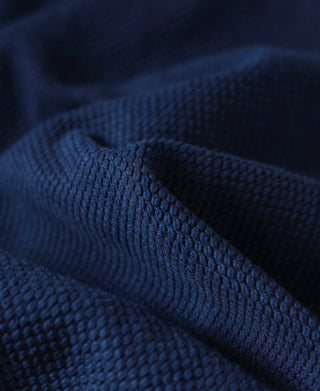- 5'7" / 170cm and 154lbs / 70kg. He wears a size S.
- 5'10" / 178cm and 165lbs / 75kg. He wears a size M.
- 5'11" / 180cm and 176lbs / 80kg. He wears a size L.
- 6' / 183cm and 191lbs / 87kg. He wears a size XL.
- 6'2" / 185cm and 209lbs / 95kg. He wears a size XXL.
Inspired by classic fishermen’s sweaters from the early 20th century, this piece traces its origins to the maritime traditions where knitwear served as essential protection against wind and cold at sea. The style later evolved into a timeless staple embraced by casual and Ivy style alike.
Crafted from 100% wool, it’s pre-shrunk for stability and delivers a dense yet soft hand feel with exceptional warmth and comfort. Made with a unique blended-yarn construction, creating subtle color depth and a rich, heathered texture.
- Classic fit.
- Roll Neck.
- Long sleeves with rib-knit cuffs.
- Rib-knit hem.
- An eco-friendly wash process for a soft, natural feel.
- Knit with 100% Pure Wool.
- Pre-shrunk to let the shape hold well.
- Do not bleach.
- Flat to dry in the shade. Store folded.
- Iron at a low temperature with a cloth barrier.
- Professional dry clean only.
- Model is 5' 10"/178cm and 161lbs/73kg. He wears a size M.
| Size | Shoulder | Chest |
| S | 18.9" / 48cm | 44.1" / 112cm |
| M | 19.7" / 50cm | 46.5" / 118cm |
| L | 20.5" / 52cm | 48.8" / 124cm |
| XL | 21.3" / 54cm | 51.2" / 130cm |
| XXL | 22" / 56cm | 53.5" / 136cm |
| Size | Length | Sleeve |
| S | 27.2" / 69cm | 23.6" / 60cm |
| M |
27.6" / 70cm | 24" / 61cm |
| L | 28" / 71cm | 24.4" / 62cm |
| XL | 28.3" / 72cm | 24.8" / 63cm |
| XXL | 28.7" / 73cm | 25.2" / 64cm |
In order to best determine fit, it may be helpful to compare our garment’s measurements to a similar garment you already own. Lay your garment on a flat surface and take all measurements from the outside of the garment.
Click here to check out our Garment Measuring Guide.
** If you are still confused, you can Contact Us to help you choose the size. **
- Free shipping on orders $59 (U.S. dollar), Otherwise, a shipping fee of $6.99 will be charged.
- Time Catcher offers 30 day returns. - Return Policy
** All items must be returned in unused, original condition with tags attached. **
Indigo-Dyed Sashiko Work Jacket
- Unit price
- /per
Free Shipping On $59 + Easy 30-day Returns
Have questions? Contact Us
Adding product to your cart
- 5'7" / 170cm and 154lbs / 70kg. He wears a size S.
- 5'10" / 178cm and 165lbs / 75kg. He wears a size M.
- 5'11" / 180cm and 176lbs / 80kg. He wears a size L.
- 6' / 183cm and 191lbs / 87kg. He wears a size XL.
- 6'2" / 185cm and 209lbs / 95kg. He wears a size XXL.
Inspired by classic fishermen’s sweaters from the early 20th century, this piece traces its origins to the maritime traditions where knitwear served as essential protection against wind and cold at sea. The style later evolved into a timeless staple embraced by casual and Ivy style alike.
Crafted from 100% wool, it’s pre-shrunk for stability and delivers a dense yet soft hand feel with exceptional warmth and comfort. Made with a unique blended-yarn construction, creating subtle color depth and a rich, heathered texture.
- Classic fit.
- Roll Neck.
- Long sleeves with rib-knit cuffs.
- Rib-knit hem.
- An eco-friendly wash process for a soft, natural feel.
- Knit with 100% Pure Wool.
- Pre-shrunk to let the shape hold well.
- Do not bleach.
- Flat to dry in the shade. Store folded.
- Iron at a low temperature with a cloth barrier.
- Professional dry clean only.
- Model is 5' 10"/178cm and 161lbs/73kg. He wears a size M.
| Size | Shoulder | Chest |
| S | 18.9" / 48cm | 44.1" / 112cm |
| M | 19.7" / 50cm | 46.5" / 118cm |
| L | 20.5" / 52cm | 48.8" / 124cm |
| XL | 21.3" / 54cm | 51.2" / 130cm |
| XXL | 22" / 56cm | 53.5" / 136cm |
| Size | Length | Sleeve |
| S | 27.2" / 69cm | 23.6" / 60cm |
| M |
27.6" / 70cm | 24" / 61cm |
| L | 28" / 71cm | 24.4" / 62cm |
| XL | 28.3" / 72cm | 24.8" / 63cm |
| XXL | 28.7" / 73cm | 25.2" / 64cm |
In order to best determine fit, it may be helpful to compare our garment’s measurements to a similar garment you already own. Lay your garment on a flat surface and take all measurements from the outside of the garment.
Click here to check out our Garment Measuring Guide.
** If you are still confused, you can Contact Us to help you choose the size. **
- Free shipping on orders $59 (U.S. dollar), Otherwise, a shipping fee of $6.99 will be charged.
- Time Catcher offers 30 day returns. - Return Policy
** All items must be returned in unused, original condition with tags attached. **
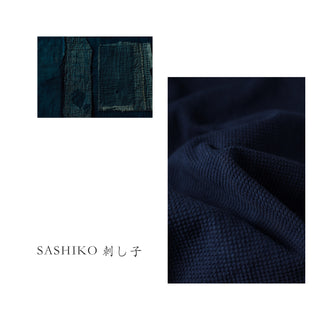
Sashiko
Sashiko (刺し子, lit. 'little stabs') is a type of traditional Japanese embroidery or stitching used for the decorative and/or functional reinforcement of cloth and clothing.
First coming into existence in the Edo period (1603–1867), sashiko embroidery was first applied to clothing out of a practical need and would have been used to strengthen the homespun clothes of olden times. Worn-out clothes were pieced together to make new garments by using simple running stitches. These clothes increased their strength with this durable embroidery. By the Meiji period (1868–1912), sashiko had been established enough to evolve into winter work in northern farming communities when it was too cold to work outside.
Sashiko was commonly used to reinforce already-patched clothing around points of wear, but it would also be used to attach patches to clothing, ultimately making the fabric stronger. It would also be used to layer thin fabrics to create warmth and, in the case of some garments such as the coats of firemen, to create a thick and absorbent material that would be soaked in water before carrying out duties as a fireman. Though most sashiko utilizes only a plain running stitch technique, sashiko is commonly used to create decorative and repeated embroidered patterns and may be used for purely decorative purposes, such as in the creation of quilts and embroidery samplers.
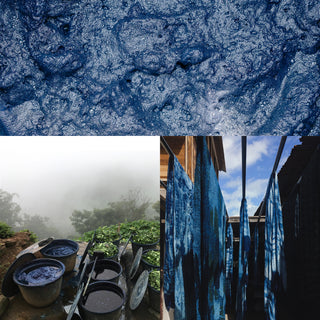
Indigo Dye
The first discovery of indigo-dyed fabric dates back to Peru, around 6000 years ago. The ancient art of natural dyeing, particularly with indigo, has its roots in China and Africa, with China being renowned for its exceptional techniques.
Unlike chemical dyes, which produce a single tone, the natural dyeing technique reveals a rich spectrum of colors. From delightful blues to cloudy grays, each plant imparts a unique hue that chemical dyes can't replicate. This characteristic lends itself to personalization, changing with wear to create a unique appearance. The process, from plant picking to creating the dye, is time-consuming. The final color is influenced by the specific parts of the plants chosen for the dye. Each dyeing process requires multiple water rinses until the color becomes solid and rich.

